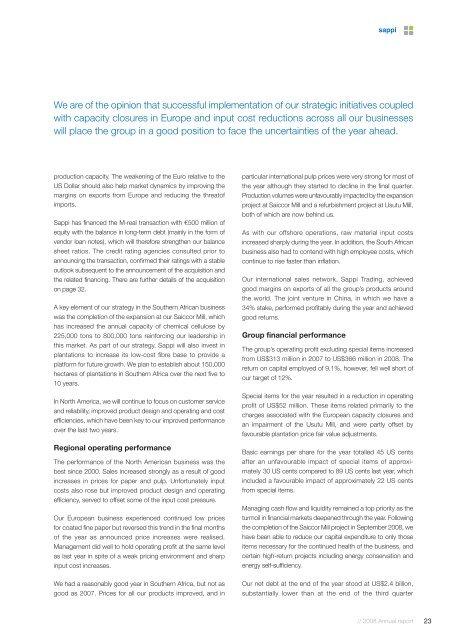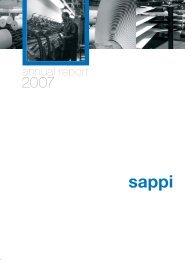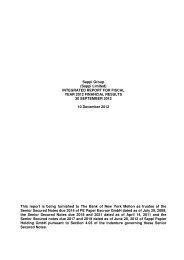2008 Annual report - Sappi
2008 Annual report - Sappi
2008 Annual report - Sappi
You also want an ePaper? Increase the reach of your titles
YUMPU automatically turns print PDFs into web optimized ePapers that Google loves.
sappi<br />
We are of the opinion that successful implementation of our strategic initiatives coupled<br />
with capacity closures in Europe and input cost reductions across all our businesses<br />
will place the group in a good position to face the uncertainties of the year ahead.<br />
production capacity. The weakening of the Euro relative to the<br />
US Dollar should also help market dynamics by improving the<br />
margins on exports from Europe and reducing the threatof<br />
imports.<br />
<strong>Sappi</strong> has financed the M-real transaction with J500 million of<br />
equity with the balance in long-term debt (mainly in the form of<br />
vendor loan notes), which will therefore strengthen our balance<br />
sheet ratios. The credit rating agencies consulted prior to<br />
announcing the transaction, confirmed their ratings with a stable<br />
outlook subsequent to the announcement of the acquisition and<br />
the related financing. There are further details of the acquisition<br />
on page 32.<br />
A key element of our strategy in the Southern African business<br />
was the completion of the expansion at our Saiccor Mill, which<br />
has increased the annual capacity of chemical cellulose by<br />
225,000 tons to 800,000 tons reinforcing our leadership in<br />
this market. As part of our strategy, <strong>Sappi</strong> will also invest in<br />
plantations to increase its low-cost fibre base to provide a<br />
platform for future growth. We plan to establish about 150,000<br />
hectares of plantations in Southern Africa over the next five to<br />
10 years.<br />
In North America, we will continue to focus on customer service<br />
and reliability, improved product design and operating and cost<br />
efficiencies, which have been key to our improved performance<br />
over the last two years.<br />
Regional operating performance<br />
The performance of the North American business was the<br />
best since 2000. Sales increased strongly as a result of good<br />
increases in prices for paper and pulp. Unfortunately input<br />
costs also rose but improved product design and operating<br />
efficiency, served to offset some of the input cost pressure.<br />
Our European business experienced continued low prices<br />
for coated fine paper but reversed this trend in the final months<br />
of the year as announced price increases were realised.<br />
Management did well to hold operating profit at the same level<br />
as last year in spite of a weak pricing environment and sharp<br />
input cost increases.<br />
particular international pulp prices were very strong for most of<br />
the year although they started to decline in the final quarter.<br />
Production volumes were unfavourably impacted by the expansion<br />
project at Saiccor Mill and a refurbishment project at Usutu Mill,<br />
both of which are now behind us.<br />
As with our offshore operations, raw material input costs<br />
increased sharply during the year. In addition, the South African<br />
business also had to contend with high employee costs, which<br />
continue to rise faster than inflation.<br />
Our international sales network, <strong>Sappi</strong> Trading, achieved<br />
good margins on exports of all the group’s products around<br />
the world. The joint venture in China, in which we have a<br />
34% stake, performed profitably during the year and achieved<br />
good returns.<br />
Group financial performance<br />
The group’s operating profit excluding special items increased<br />
from US$313 million in 2007 to US$366 million in <strong>2008</strong>. The<br />
return on capital employed of 9.1%, however, fell well short of<br />
our target of 12%.<br />
Special items for the year resulted in a reduction in operating<br />
profit of US$52 million. These items related primarily to the<br />
charges associated with the European capacity closures and<br />
an impairment of the Usutu Mill, and were partly offset by<br />
favourable plantation price fair value adjustments.<br />
Basic earnings per share for the year totalled 45 US cents<br />
after an unfavourable impact of special items of approxi -<br />
mately 30 US cents compared to 89 US cents last year, which<br />
included a favourable impact of approximately 22 US cents<br />
from special items.<br />
Managing cash flow and liquidity remained a top priority as the<br />
turmoil in financial markets deepened through the year. Following<br />
the completion of the Saiccor Mill project in September <strong>2008</strong>, we<br />
have been able to reduce our capital expenditure to only those<br />
items necessary for the continued health of the business, and<br />
certain high-return projects including energy conservation and<br />
energy self-sufficiency.<br />
We had a reasonably good year in Southern Africa, but not as<br />
good as 2007. Prices for all our products improved, and in<br />
Our net debt at the end of the year stood at US$2.4 billion,<br />
substantially lower than at the end of the third quarter<br />
// <strong>2008</strong> <strong>Annual</strong> <strong>report</strong><br />
23
















